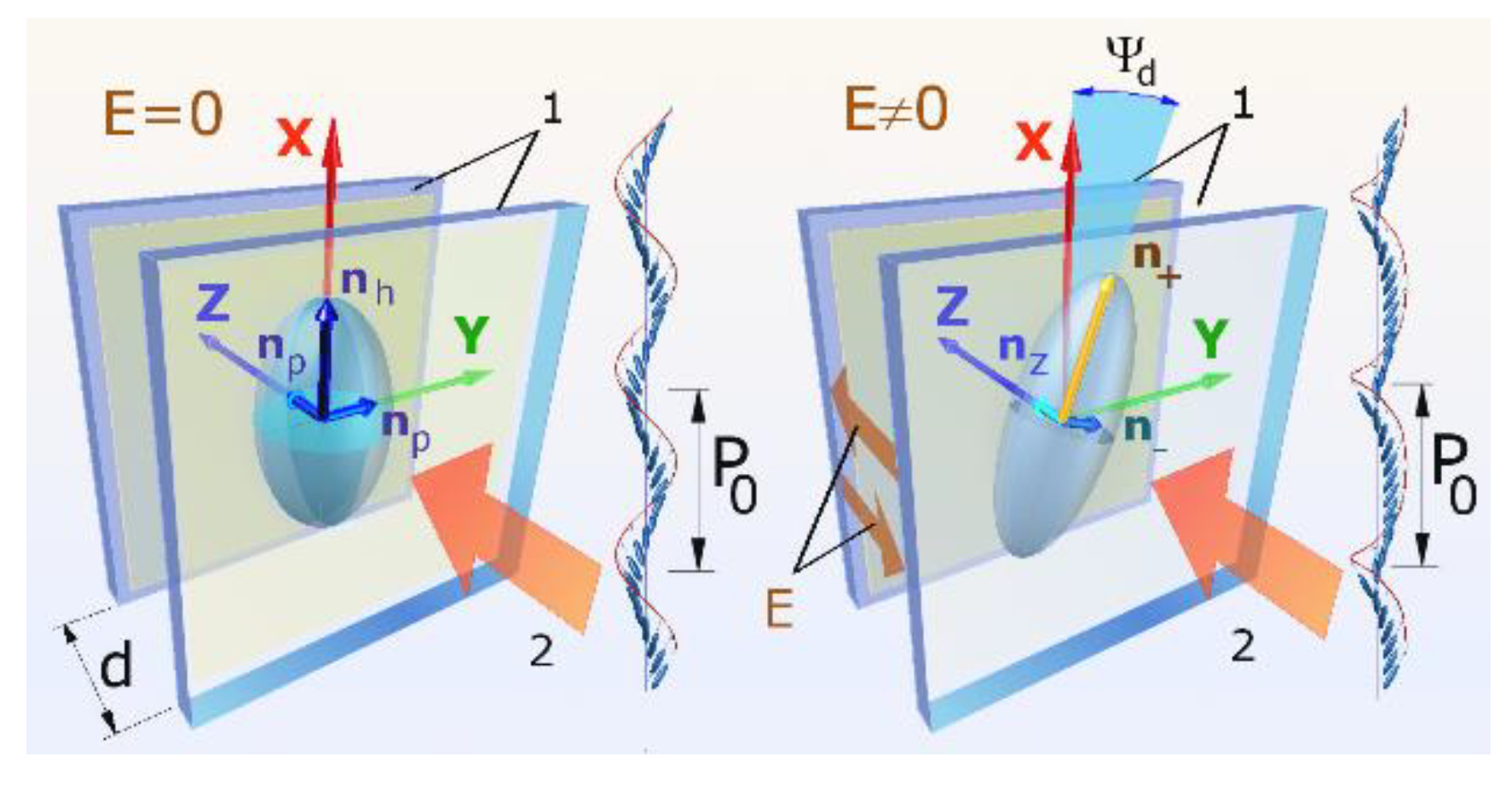In-plane Switching Deformed Helix Ferroelectric Liquid Crystal Display Cells
Abstract
1. Introduction
2. Experimental Results and Discussion
3. Conclusions
Author Contributions
Funding
Acknowledgments
Conflicts of Interest
References
- Oh-E, M.; Kondo, K. Electro-optical characteristics and switching behavior of the in-plane switching mode. Appl. Phys. Lett. 1995, 67, 3895. [Google Scholar] [CrossRef]
- Oh-E, M.; Kondo, K. Response mechanism of nematic liquid crystals using the in-plane switching mode. Appl. Phys. Lett. 1996, 69, 623. [Google Scholar] [CrossRef]
- Oh-E, M.; Kondo, K. The in-plane switching of homogeneously aligned nematic liquid crystals. Liq. Cryst. 1997, 22, 379. [Google Scholar] [CrossRef]
- Oh-E, M.; Yoneya, M.; Ohta, M.; Kondo, K. Dependence of viewing angle characteristics on pretilt angle in the in-plane switching mode. Liq. Cryst. 1997, 22, 391. [Google Scholar] [CrossRef]
- Beresnev, L.A.; Chigrinov, V.G.; Dergachev, D.I.; Pozhidaev, E.P.; Funfshilling, J.; Schadt, M. Deformed helix ferroelectric liquid crystal display—A new electrooptic mode in ferroelectric smectic C* liquid crystals. Liq. Cryst. 1989, 5, 1171. [Google Scholar] [CrossRef]
- Pozhidaev, E.; Torgova, S.; Minchenko, M.; Yednak, C.A.R.; Strigazzi, A.; Miraldi, E. Phase modulation and ellipticity of the light transmitted through a smectic C* layer with short helix pitch. Liq. Cryst. 2010, 37, 1067. [Google Scholar] [CrossRef]
- Kiselev, A.D.; Pozhidaev, E.P.; Chigrinov, V.G.; Kwok, H.S. Polarization-gratings approach to deformed-helix ferroelectric liquid crystals with subwavelength pitch. Phys. Rev. E 2011, 83, 031703. [Google Scholar] [CrossRef] [PubMed]
- Kotova, S.P.; Samagin, S.A.; Pozhidaev, E.P.; Kiselev, A.D. Light modulation in planar aligned short-pitch deformed-helix ferroelectric liquid crystals. Phys. Rev. E 2015, 92, 062502. [Google Scholar] [CrossRef] [PubMed]
- Kesaev, V.V.; Kiselev, A.D.; Pozhidaev, E.P. Modulation of unpolarized light in planar-aligned subwavelength-pitch deformed-helix ferroelectric liquid crystals. Phys. Rev. E 2017, 95, 032705. [Google Scholar]
- Pozhidaev, E.P.; Schrivastava, A.K.; Kiselev, A.D.; Chigrinov, V.G.; Vashchenko, V.V.; Krivoshey, A.I.; Minchenko, M.V.; Kwok, H.S. Enhanced orientational Kerr effect in vertically aligned deformed helix ferroelectric liquid crystals. Opt. Lett. 2014, 39, 2900. [Google Scholar] [CrossRef] [PubMed]
- Hubert, P.; Jägemalm, P.; Oldano, C.; Rajteri, M. Optic models for short-pitch cholesteric and chiral smectic liquid crystals. Phys. Rev. E 1998, 58, 3264. [Google Scholar] [CrossRef]
- Mikhailenko, V.; Krivoshey, A.; Pozhidaev, E.; Popova, E.; Fedoryako, A.; Gamzaeva, S.; Barbashov, V.; Srivastava, A.K.; Kwok, H.S.; Vashchenko, V. The nano-scale pitch ferroelectric liquid crystal materials for modern display and photonic application employing highly effective chiral components: Trifluoromethylalkyl diesters of p-terphenyldicarboxylic acid. J. Mol. Liquids 2019, 281, 186. [Google Scholar] [CrossRef]




© 2019 by the authors. Licensee MDPI, Basel, Switzerland. This article is an open access article distributed under the terms and conditions of the Creative Commons Attribution (CC BY) license (http://creativecommons.org/licenses/by/4.0/).
Share and Cite
Pozhidaev, E.P.; Tkachenko, T.P.; Kuznetsov, A.V.; Kompanets, I.N. In-plane Switching Deformed Helix Ferroelectric Liquid Crystal Display Cells. Crystals 2019, 9, 543. https://doi.org/10.3390/cryst9100543
Pozhidaev EP, Tkachenko TP, Kuznetsov AV, Kompanets IN. In-plane Switching Deformed Helix Ferroelectric Liquid Crystal Display Cells. Crystals. 2019; 9(10):543. https://doi.org/10.3390/cryst9100543
Chicago/Turabian StylePozhidaev, Evgeny P., Timofey P. Tkachenko, Artemy V. Kuznetsov, and Igor N. Kompanets. 2019. "In-plane Switching Deformed Helix Ferroelectric Liquid Crystal Display Cells" Crystals 9, no. 10: 543. https://doi.org/10.3390/cryst9100543
APA StylePozhidaev, E. P., Tkachenko, T. P., Kuznetsov, A. V., & Kompanets, I. N. (2019). In-plane Switching Deformed Helix Ferroelectric Liquid Crystal Display Cells. Crystals, 9(10), 543. https://doi.org/10.3390/cryst9100543



